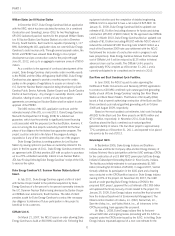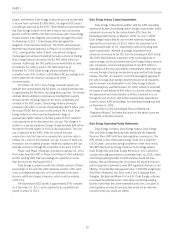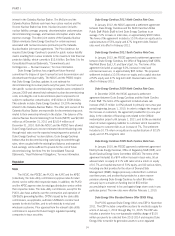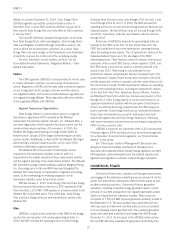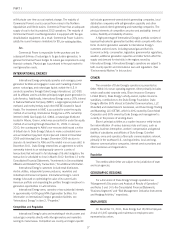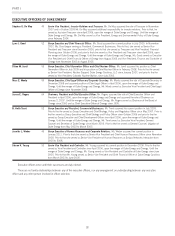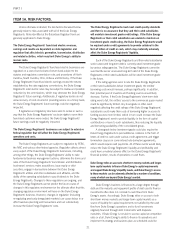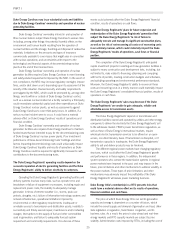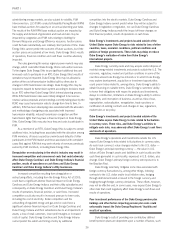Duke Energy 2011 Annual Report Download - page 36
Download and view the complete annual report
Please find page 36 of the 2011 Duke Energy annual report below. You can navigate through the pages in the report by either clicking on the pages listed below, or by using the keyword search tool below to find specific information within the annual report.
PART I
Duke Energy Ohio’s retail load obligation as of January 1, 2012. As a
result, Duke Energy Ohio’s coal-fired generation assets no longer
serve retail load customers or receive negotiated pricing under the
ESP. The generation assets began selling all of their electricity into
wholesale markets in January 2012 and going forward will receive
wholesale energy margins and capacity revenues from PJM at rates
currently below those previously collected under the prior ESP. These
lower energy margins and capacity revenues are expected to be
partially offset by a non-bypassable stability charge collected from
Duke Energy Ohio’s retail customers through 2014. Commercial
Power has fully hedged its forecasted coal-fired generation. Capacity
revenues are 100% contracted in PJM through May 2015.
For information on Commercial Power’s generation facilities, see
“Commercial Power” in Item 2, “Properties”
Commercial Power also has a retail sales subsidiary, Duke
Energy Retail Sales, LLC (Duke Energy Retail), which is certified by
the PUCO as a Competitive Retail Electric Supplier (CRES) provider in
Ohio. Duke Energy Retail serves retail electric customers in
southwest, west central and northern Ohio with energy and other
energy services at competitive rates. Due to increased levels of
customer switching as a result of the competitive markets in Ohio,
which is discussed further below, Duke Energy Retail has focused on
acquiring customers that had previously been served by Duke Energy
Ohio under the ESP, as well as those previously served by other Ohio
franchised utilities.
Through Duke Energy Generation Services, Inc. (DEGS),
Commercial Power engages in the development, construction and
operation of renewable energy projects. Currently, DEGS has a
significant pipeline of development projects and approximately 1,100
net MW of renewable generating capacity in operation as of
December 31, 2011. In addition, DEGS develops commercial
transmission projects. DEGS also owns and operates electric
generation for large energy consumers, municipalities, utilities and
industrial facilities. DEGS currently manages approximately 3,700
MW of power generation at various sites throughout the U.S.
Rates and Regulation
Effective January 1, 2009, Commercial Power’s primarily coal-
fired generation assets began operating under the Duke Energy Ohio
ESP, which expired on December 31, 2011. Prior to the ESP, these
generation assets had been contracted through the Rate Stabilization
Plan (RSP), which expired on December 31, 2008.
Prior to December 17, 2008, Commercial Power did not apply
regulatory accounting treatment to any of its operations due to the
comprehensive electric deregulation legislation passed by the state of
Ohio in 1999. In April 2008, new legislation (SB 221) was passed
in Ohio and signed by the Governor of Ohio in May 2008. This law
codified the PUCO’s authority to approve an electric utility’s Standard
ServiceOffereitherthroughanESPoraMarketRateOffer(MRO),
which is a price determined through a competitive bidding process.
In July 2008, Duke Energy Ohio filed an ESP and, with certain
amendments, the ESP was approved by the PUCO on December 17,
2008. The approval of the ESP on December 17, 2008 resulted in
the reapplication of regulatory accounting treatment to certain
portions of Commercial Power’s operations as of that date. The ESP
became effective on January 1, 2009.
Despite certain portions of the Ohio retail load operations not
meeting the criteria for applying regulatory accounting treatment, all
of Commercial Power’s Ohio retail load operations’ rates were subject
to approval by the PUCO through December 2011, and thus these
operations, through December 31, 2011, were referred to here-in as
Commercial Power’s regulated operations.
As discussed in the USFE&G section above, the PUCO
approved Duke Energy Ohio’s new ESP in November
2011.In November 2011, as a result of changes resulting from the
PUCO’s approval of the new ESP, Commercial Power stopped
applying regulatory accounting treatment to its Ohio operations. As of
December 31, 2011, no portion of Commercial Power applies
regulatory accounting.
For more information on rate matters, see Note 4 to the
Consolidated Financial Statements, “Regulatory Matters — Rate
Related Information.”
Commercial Power is subject to regulation at the federal level,
primarily from FERC. Regulations of FERC govern access to regulated
electric customer and other data by non-regulated entities, and
services provided between regulated and non-regulated energy
affiliates. These regulations affect the activities of Commercial Power.
Commercial Power is subject to the jurisdiction of the EPA and
state and local environmental agencies. (For a discussion of
environmental regulation, see “Environmental Matters” in this section.)
See “Other Issues” section of Management’s Discussion and
Analysis of Financial Condition and Results of Operations for a
discussion about potential Global Climate Change legislation and the
potential impacts such legislation could have on Duke Energy’s
operations.
Market Environment and Competition
Commercial Power competes for wholesale contracts for the
purchase and sale of electricity, coal, natural gas and emission
allowances. The market price of commodities and services, along
with the quality and reliability of services provided, drive competition
in the energy marketing business. Commercial Power’s main
competitors include other non-regulated generators in the Midwestern
U.S., wholesale power providers, coal and natural gas suppliers, and
renewable energy.
Fuel Supply
Commercial Power relies on coal and natural gas for its
generation of electric energy.
Coal.
Commercial Power meets its coal demand through a portfolio of
purchase supply contracts and spot agreements. Large amounts of
coal are purchased under supply contracts with mining operators
who mine both underground and at the surface. Commercial Power
uses spot-market purchases to meet coal requirements not met by
supply contracts. Expiration dates for its supply contracts, which have
various price adjustment provisions and market re-openers, range
through 2018. Commercial Power expects to renew these contracts
or enter into similar contracts with other suppliers for the quantities
and quality of coal required as existing contracts expire, though prices
16




